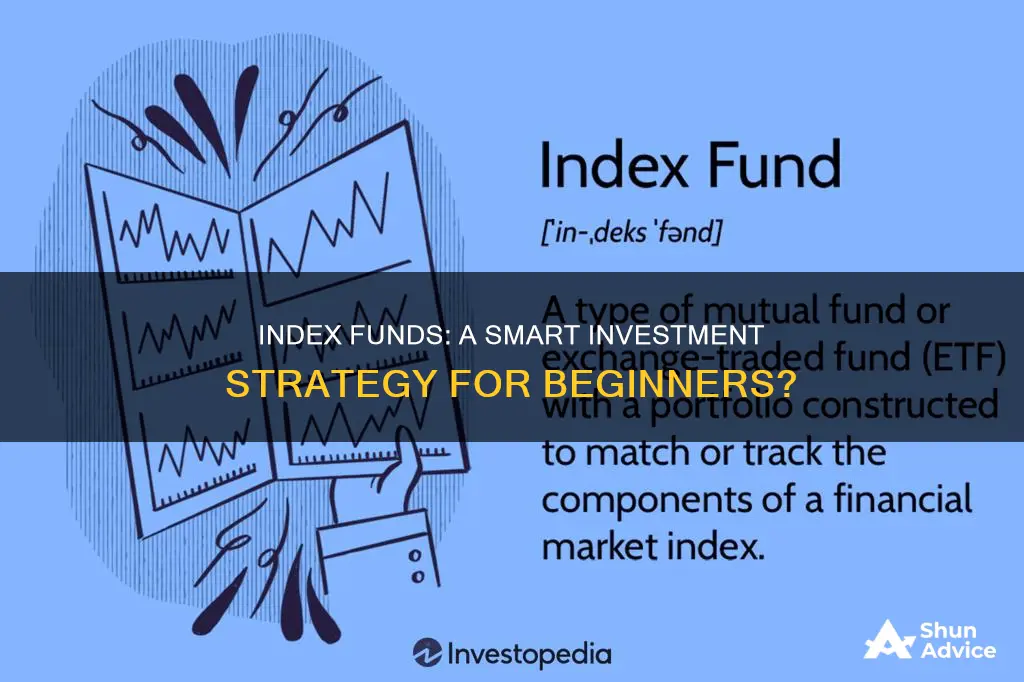
Index funds are a type of mutual or exchange-traded fund (ETF) that tracks the performance of a market index, such as the S&P 500, by holding the same stocks or bonds or a representative sample of them. They are defined as investments that mirror the performance of benchmarks like the S&P 500 by mimicking their makeup. Index funds are considered a passive investment, using a long-term strategy without actively picking securities or timing the market. They are a low-cost, easy way to build wealth and are therefore popular with retirement investors.
| Characteristics | Values |
|---|---|
| Investment type | Mutual fund or exchange-traded fund (ETF) |
| Investment vehicle | Aims to match the returns of a specific market index |
| Investment strategy | Passive |
| Costs | Low fees |
| Risk | Low |
| Returns | Strong long-term returns |
| Tax | Tax-efficient |
| Performance | Outperform actively managed funds |
| Management | No active management required |
| Diversification | Diversified portfolio |
| Investment minimum | Varies, some have no minimum |
| Investment horizon | Long-term |
What You'll Learn

What are index funds?
Index funds are a type of mutual or exchange-traded fund (ETF) that tracks the performance of a market index, such as the S&P 500, by holding the same stocks or bonds or a representative sample of them. They are defined as investments that mirror the performance of benchmarks like the S&P 500 by mimicking their makeup.
Index funds are passive investments, meaning they employ a long-term strategy without actively picking securities or attempting to time the market. They are considered a low-cost, low-risk way to build wealth and are therefore recommended by financial experts as the best investing vehicle for most people.
Index funds are also highly diversified, meaning that investors benefit from the positive effects of diversification, such as increasing the expected return of the portfolio while minimising the overall risk.
The specific uses of index funds can vary based on your financial plan, but typically they outperform actively managed funds over the long run, particularly for stock investing, largely because of low fees.
There are many different indexes to choose from that reach a wide variety of sectors and markets. Some examples include:
- Equity index funds, or stock index funds, track stock market indexes, such as the S&P 500 or Nasdaq-100.
- Bond index funds simply track bond indexes, which may include assets like US Treasuries, corporate bonds, or municipal bonds.
- International index funds follow indexes outside of the US, such as the FTSE Global All Cap ex US Index.
- Sector-specific index funds allow investors to gain some diversification while betting on a particular sector, such as technology, healthcare, or energy.
When choosing an index fund, it is important to research the differences between each offering within a broad index. Some factors to consider include the fund's assets under management (AUM), fee structure, ease of trading and access to the fund, and the background of the managers in charge of the fund.
The Future of Investing: Funds to Focus On
You may want to see also

What are the pros and cons?
Index funds are a popular investment choice due to their potential for stable long-term returns, diversification, and low fees. However, they also have some drawbacks. Here is a detailed look at the pros and cons of investing in index funds:
Pros:
- Low fees and costs: Index funds are passively managed, meaning they have lower management fees than actively managed funds. They also tend to have lower transaction costs as they trade less frequently.
- Diversification: Index funds provide access to a diversified portfolio of stocks, bonds, or other securities, reducing the risk of significant losses from any one investment.
- Simplicity and ease: Index funds are straightforward investment options that don't require extensive research or active management. They are often considered a good choice for beginners.
- Historical performance: Over the long term, index funds have consistently outperformed actively managed funds, especially after accounting for fees and expenses.
- Tax efficiency: The lower turnover rates in index funds result in fewer capital gains distributions, making them more tax-efficient.
Cons:
- Lack of downside protection: Index funds rise and fall with the market they track. During prolonged downturns, these funds can perform poorly, and they don't offer the flexibility to pivot to a new strategy.
- Lack of reactive ability: Index funds cannot take advantage of opportunities to adjust the portfolio when a stock becomes overvalued.
- No control over holdings: Investors in index funds cannot choose the individual holdings in the portfolio and may end up investing in companies they don't believe in or wish to avoid.
- Limited exposure to different strategies: Index funds may not provide access to diverse investment strategies, as they are tied to a specific market index.
- Dampened personal satisfaction: Investing in index funds can still be stressful, as you are at the mercy of the market's performance, and you don't get the satisfaction of making individual investment choices.
- Moderate annual returns: Due to their diversified nature, index funds may provide more moderate returns than riskier investments like individual stocks or crypto.
- Fewer opportunities for short-term growth: Index funds are designed for long-term gains and may not provide the same potential for quick, significant short-term growth as other investments.
Best Funds to Maximize Your 401k Returns
You may want to see also

How do I choose the right one?
When choosing the right index fund, it's important to consider your financial goals, risk tolerance, and budget. Here are some key factors to keep in mind:
- Investment goals and timeline: Determine whether you are investing for the short term or long term. If you have a short-term goal, you may prefer a more conservative approach with lower-risk investments. For long-term goals like retirement, you can consider taking on more risk with equity index funds.
- Risk appetite: Assess your comfort with risk. If you have a low-risk tolerance, you may want to allocate a larger portion of your portfolio to bond index funds. If you're comfortable with more risk, you can consider investing a higher percentage in equity index funds.
- Types of indexes: Research the different types of indexes available, such as broad, large-cap stock indexes (e.g., S&P 500, NASDAQ 1000), small-cap indexes (e.g., Russell 2000, S&P 600), bond indexes (e.g., Bloomberg Barclays U.S. Aggregate Bond Index), and international indexes. Choose the indexes that align with your risk tolerance and investment goals.
- Fees and expenses: Compare the fees and expense ratios of different index funds. Look for funds with low expense ratios, as these fees can eat into your returns over time. Be mindful of other fees such as sales loads, transaction costs, and investment minimums.
- Performance and tracking error: Evaluate the historical performance of the index funds you're considering. While past performance doesn't guarantee future results, it can give you an idea of how the fund has fared over time. Also, check the tracking error, which indicates how closely the fund follows its underlying index.
- Fund size and liquidity: Larger funds often offer more liquidity and lower trading costs. However, compare the trading costs and liquidity of different funds to find the most suitable option for your needs.
- Tax efficiency: Consider the tax implications of investing in index funds, especially if you're investing in a taxable brokerage account. Index funds with lower turnover rates tend to be more tax-efficient, as they generate fewer capital gains distributions.
- Fund company and management: Research the fund company and the fund managers. Look into their reputation, track record, and investment strategy. You can also compare the fees and services offered by different fund companies.
- Your values: Think about how your investments can align with your values. For example, if you want to support environmental causes, you can consider clean-energy or ESG (environmental, social, and governance) index funds.
- Seek professional advice: If you're unsure or need help tailoring your index fund investments to your specific needs, consider consulting a financial advisor or a certified financial planner (CFP). They can provide personalized guidance based on your financial situation and goals.
Creating a Family Investment Fund: A Guide for Beginners
You may want to see also

How do I buy them?
There are several steps to buying index funds.
First, you need to have a goal for your investment. Ask yourself what you want your money to do for you. If you're looking for a short-term investment, index funds may not be the best option.
Second, research the index funds you're interested in. Consider the company size and capitalization, geography, business sector or industry, asset type, and market opportunities.
Third, pick the index fund you want to buy. Cost is an important factor here—bigger funds tend to have lower fees.
Fourth, decide where to buy your index funds. You can purchase them directly from a mutual fund company or a brokerage. You can also buy exchange-traded funds (ETFs), which are like mini mutual funds that trade like stocks throughout the day. When choosing where to buy, consider fund selection, convenience, trading costs, impact investing, and commission-free options.
Fifth, open an investment account. You'll need one of these to purchase shares of an index fund. A brokerage account, individual retirement account (IRA), or Roth IRA will all work.
Finally, keep an eye on your index funds. While index funds are a passive management strategy, you should still monitor their performance over time.
Strategic Development: Unlocking Investment Opportunities
You may want to see also

How do I manage my investment?
Index funds are a passive investment strategy, meaning they don't require active management. They are designed to replicate the performance of a specific market index, such as the S&P 500, and are ideal for long-term investing.
- Have a clear goal: Before investing in index funds, it is important to understand your financial goals and risk tolerance. Are you investing for the short term or long term? What level of risk are you comfortable with? Knowing your goals will help you choose the right index funds and manage your investment effectively.
- Research and choose the right index funds: There are various types of index funds available, tracking different market indexes and focusing on different sectors, industries, or asset types. Research the performance history, management fees, and the index tracked by each fund. Diversifying your portfolio by investing in multiple index funds can help manage risk.
- Select a suitable platform: Choose an online brokerage or investment platform that provides strong customer support, robust research tools, and analytical tools to help you make informed decisions. Consider the fees and features offered by different platforms.
- Open and fund your account: Provide the necessary personal information, set up your login credentials, and complete any required questionnaires. Fund your account through a bank transfer or other accepted methods.
- Buy shares of your chosen index funds: Most platforms allow you to purchase shares directly through their website or app. Compare the costs and features of buying shares through a brokerage or directly from a fund provider. Consider the impact of fees on your long-term returns.
- Monitor and adjust your portfolio periodically: While index funds are typically long-term investments, it is important to periodically review your portfolio to ensure it remains aligned with your financial goals and risk tolerance. Check if the index fund is mirroring the performance of its underlying index and review the fees to ensure they don't negatively impact your returns.
- Consider seeking professional advice: Consult a financial advisor to guide you in selecting funds that align with your goals and risk tolerance. This is especially helpful if you have a complex financial situation or need help with tax implications and portfolio rebalancing.
- Stay informed about market trends and index fund news: Stay up to date with market trends, economic conditions, and news related to the indexes and industries your funds are invested in. This will help you make informed decisions about buying, holding, or selling your index funds.
- Consider diversification and risk management: Index funds provide diversification by investing in a broad range of stocks or bonds within a specific index. However, you can further diversify your portfolio by investing in multiple index funds tracking different indexes. Additionally, consider other investment options besides index funds to balance your portfolio and manage risk.
- Evaluate costs and returns regularly: Index funds are known for their low fees, but it is important to monitor the costs associated with your investment, including management fees, transaction costs, and expense ratios. Ensure that the fees don't outweigh the potential returns.
Remember, index funds are generally a long-term investment strategy, and their performance may vary over time. Regularly reviewing and adjusting your investment strategy based on your financial goals and market conditions is essential for effective management.
A Beginner's Guide to Mutual Fund Investing with Small Capital
You may want to see also
Frequently asked questions
Index funds are a low-cost, easy, and effective way to build wealth. They are diversified, tax-efficient, and have consistently outperformed other types of funds in terms of total return.
One drawback is that if the market performs poorly, so will your index fund investment. Index funds also lack the flexibility to pivot away from a declining market and may include overvalued or weak companies.
When choosing an index fund, consider factors such as your personal situation, life goals, risk tolerance, and budget. Research the fund's assets under management (AUM), fee structure, ease of trading, and the background of the fund managers.
You can start by deciding whether to invest yourself or seek professional help. Then, open an investment account with a brokerage platform or investment app. Finally, purchase shares in your chosen index fund and continue to invest regularly.







